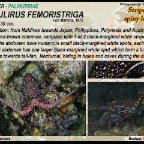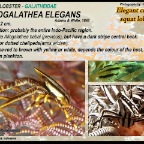Lobsters
Spiny lobsters, slipper lobsters and furry lobsters. The most known are the spiny lobsters because of gourmets. They live in submarine caves and crevices and come out at night to feed. Lobsters feed on crustacean, molluscs and algae, but are also often seen scavenging. They are characterised by the lack of true claws, a soft and flexible posterior tail fan, which they use for swimming backwards for a short distance. Length: 6 cm.Distribution: E- Africa to Taiwan, S- Japan, Indonesia, Australia and New Caledonia.A small specimen with a very variable body pattern. Different shades of brown, large blotches and sometimes paler spots. Red to dark brown triangular shaped mark behind the head. Banded walking legs. On sand, mud or coral of protected reefs, from -6 to -80 m. The photographs show a juvenile from 2,5 cm.
Length: 40 cm.Distribution: Red Sea, E- Africa, S- Japan, Melanesia, N- Australia and Polynesia.In many places also known as crayfish. Spiny lobsters don’t have claws and try toprotect themselfs with their long antennas. White antennas, pink where they are attached to the head. The body has a colour combination of blue, green, black and white. The tailfan is green to blue. Length: 30 cm.Distribution: from Maldives towards Japan, Philippines, Polynesia and Australia.Pale to red-brown antennae, carapace with 1 or 2 black-margined white stripes on the sides. The abdomen have numerous small black-margined white spots, each segment from the abdomen has one larger black-margined white spot which form a line from carapace towards tail-fan. Nocturnal, hiding in holes and caves during the day. Length: 1,5 cm.Distribution: only known from Philippines and Indonesia.Very easy to recognise because of it’s pink colour and hairy body and legs.Fine purple stripes on top of the body and legs. The chelipeds(arms w/ claw) have small purple spots. Can be found on sponges (Xestosspongia).
Length: 8 cm. Distribution: known from the whole W- Pacific. The body is around 0,6 cm and all the rest is legs. Can be found on various types of coral, down to -20 m. White spots on top of the legs. Length: 2 cm.Distribution: Red Sea & E- Africa to the Philippines, Australia and New Caledonia.A long-nosed specimen which lives on featherstars. The first pair of legs are almost twice the body-length. Colour depends on the host, but the pattern stays the same. The broad bands go from the rear end of the body down the chelipeds (arms w/ claw). Feeds on plankton, which it takes from it’s host’s arms. Females, larger than male.

Panulirus femorstriga - Stripe-leg spiny lobster

Panulirus versicolor - Painted spiny lobster

Gibbularctus gibberosus - Darkspot locust lobster

Lauriea siagiani - Hairy squat lobster

Allogalathea babai - Baba's crinoid squat lobster

Allogalathea elegans - Elegant crinoid squat lobster

Galathea sp. - Squat lobster

Munida olivarae - Olivar's squat lobster

Chirostylus sandyi - Spider squat lobster


